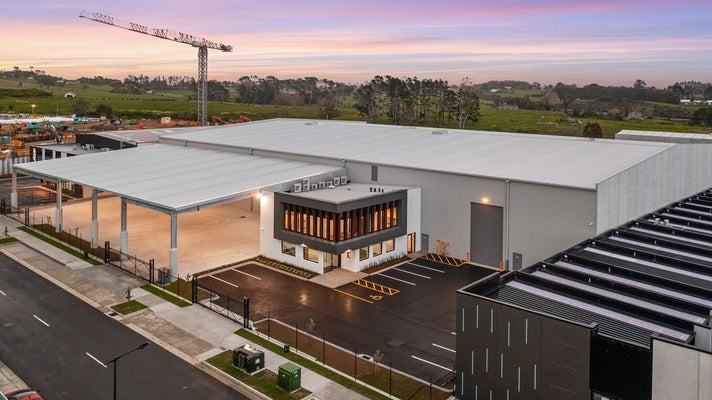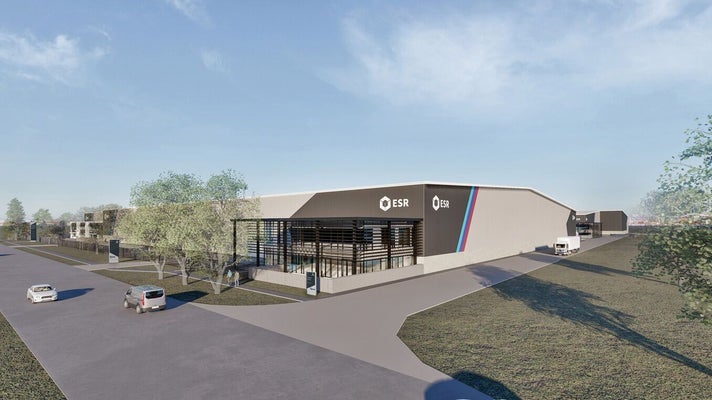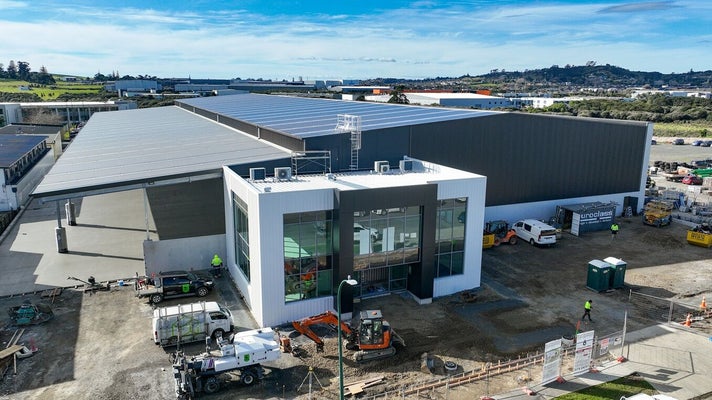Total Property -
Industrial investment market stacks up

Euroclass' speculative build at 7 Inanga Street, Hobsonville
With green shoots emerging in the industrial investment market after a period of volatility, Total Property checks in with leading developers about the opportunities ahead in a sector that just boxes on.
New Zealand’s industrial property market is showing early signs of recovery, with developers, investors, and government policy aligning to stimulate growth in key locations. While the Auckland industrial property market remains in a period of adjustment, regions within the Golden Triangle and growth hubs like Canterbury and Queenstown are attracting strong demand for warehouse, logistics, and commercial developments. Backed by favourable lease structures, active offshore capital, and new incentives for industrial and commercial property investment, the sector is entering a new growth phase that is reshaping the landscape for 2025 and beyond.
Signs of recovery in the industrial sector
The latest New Zealand Industrial Market Update from Bayleys Insights & Data team reports that although there are residual economic and systemic challenges facing industrial occupiers and building owners, positive signs from the development sector point to more buoyant times ahead.
Bayleys analyst Samantha Lee says overall vacancy rates have edged up in recent months, and expects this trend to continue in the short term as some logistics occupiers consolidate their footprints. Rents however are stable across most urban areas, without the big rental rate surges that occurred a few years back.
“Softer demand from logistics operators combined with slow decision-making and tightening of rental budgets by prospective tenants is contributing to a rise in industrial vacancy levels around the country, particularly in the main urban centres as businesses seek operational efficiencies.
“A flight to quality is still evident among larger occupiers wanting to upgrade into better spec’d spaces in core locations and this signals renewed confidence following a period of slower activity.”
Investment market edging toward a turning point
Investment sales volumes remain relatively muted with wide bid-ask spreads and lagging book values having an effect, and buyers may be facing some friction when looking to secure finance, says Lee.
“Transaction volumes remain subdued overall, with a continued disconnect between vendor and purchaser pricing expectations. That said, several recent sales of large assets signal a potential turning point.
“A survey of our brokers around the country suggests that after a period of weakness, investment market conditions are improving. Yields have risen since 2022 due to higher interest rates and although interest rates have recently fallen, yields may not reduce significantly from current levels given ongoing concerns about rising inflation.”
Strategic land positioning by developers
Lee says there’s been reasonable competition for quality industrial land, and development entities are strategically looking through the current market softness to position themselves for the next upswing in the cycle, particularly in well-connected industrial precincts.
Bayleys national director industrial and logistics, Scott Campbell says while the industrial sector is not immune to the sticky market conditions being experienced across asset classes, it’s proved to be a gutsy real estate performer.
“There’s some smart movement and strategy playing out as occupiers focus on the controllables like optimising layouts and operational processes for efficiency, seeking sustainability measures to tangibly reduce energy use, and giving more weight to amenities for the attraction and retention of staff.
“Sub-lease industrial space is starting to get soaked up as occupiers identify options to make their businesses more productive, while others are being clever with the space they already have to leverage cubic capacity.
“Trying to second guess geopolitical or global economic moves is fraught, so occupiers are playing the ball in front of them and getting on with business. Trump has upset the global supply chain apple cart and after a period of flip-flopping, we now know New Zealand’s tariff is set at 15 percent – but for how long and at what bottom line cost to our export sector remains to be seen.”
Government policy boosts development prospects
The government has recently announced several measures aimed at growing the economy, and Campbell says the industrial sector stands to benefit from new policies.
“Investment Boost allows businesses to claim 20 percent of the cost of qualifying new business assets as an expense against taxable income in the first year, and this includes the purchase of new commercial and industrial property assets, new capital improvements, and seismic or other upgrade works to depreciable property.
“Business owners may see value in buying their own building, occupiers might make automation stack up now with accelerated depreciation able to be released in the first year – likewise for new fit-out, plant and machinery.
“The government also intends to allow more overseas building materials into New Zealand's construction sector which should give the new build and retrofitting market a shot in the arm. It could also turbocharge demand for industrial space as large-scale operators dealing in construction materials look for premises, particularly in the golden triangle.”
Evidence that developers are proactively back in the market is an indicator that confidence is ramping up in the industrial sector, with the pipeline of forward work encouraging, says Campbell.
“Along with pre-committed design-builds, speculative building is back on the table and we’re fielding a lot of enquiry from developers as they look to leverage our capability in the industrial sales and leasing arena.”
Developers return with strong pipelines
National commercial/industrial property and construction firm Calder Stewart is progressing with a pipeline of work around the country from Auckland to Southland. It recently launched its master-planned industrial Milburn Quadrant north of Milton in Otago, which is directly connected to State Highway 1 and the South Island’s main trunk rail line.
Milburn Quadrant is a 200-hectare, heavy industrial-zoned precinct that will deliver the country’s largest inland port along with supporting industrial warehousing and facilities, explains Ben Stewart, Calder Stewart associate director property.
“It will provide scalable opportunities for exporters, manufacturers, and freight operators seeking reliable, long-term logistics solutions, and a power bank will provide occupiers with renewable energy generated from on-site solar and a potential off-site wind farm. There is also connectivity between Milburn Quadrant and our Awarua Quadrant project in Southland for even greater occupier scale.”
Meanwhile, two high-profile new buildings are rising on 15ha of industrial-zoned land that Calder Stewart acquired to incrementally build out in Drury South. NZ Safety Blackwoods’ new facility is at the automated storage and retrieval systems fit-out stage with its lease commencing early next year, while a distribution facility for Briscoes has almost 50 percent of the steel erected and is starting to take shape with precast panels.
The company also has numerous projects under construction and several recently completed on Calder Stewart-owned land in Christchurch where it expects to see continued demand as occupiers consider their wider property and supply chain strategies to allow greater speed to market and to deliver cost savings through growth of larger facilities in the region.
“We have developed design-build turnkey packages in a range of sizes for tenants and owner-occupiers and projects include a distribution centre for Fonterra in Hornby which they will own, a distribution centre nearing completion in Middleton for an international benchtop company committing to a long-term lease, and a storage facility for Transpower in Rolleston.
“We also have a number of speculative development projects underway and while size and timing of these projects is always a calculated guess, they offer customers a level of flexibility if they require more immediate occupancy.”
Stewart says the industrial market is resilient and while there’s currently a lack of urgency in the market with some occupiers taking longer to commit to new premises largely due to subdued business confidence, occupiers are exploring ways to make their property strategy as efficient as possible.
“That could mean consolidating existing premises, establishing automation, or introducing sustainability measures – all of which can lead to lower total occupancy costs.
“New government initiatives like the Investment Boost package will deliver both a structural incentive and timing benefit making industrial property development, investment, and upgrades materially more attractive for owners and occupiers. This not only supports the industrial property sector directly, but contributes to broader productivity, business growth and wage uplift projections.”
Stewart says construction cost inflation has decelerated in 2025, and the government’s recognition of overseas building product standards and certification schemes in New Zealand should reduce construction costs even further. He also thinks the Active Investor Plus announcement will channel high-value investment into New Zealand’s commercial and industrial property development sector.
“With a larger capital base for industrial projects, the modernisation of existing stock, and broadening of investor pools via managed funds and eligible developments, it should translate to stronger, faster growth in the industrial property market which is beneficial for tenants, developers and owners.”
Calder Stewart's development for NZ Safety Blackwoods at Drury South
Calder Stewart's Briscoes distribution centre development at Drury South
Structural growth opportunities in the market
ESR Australia and New Zealand is a real estate asset owner and manager focusing on innovative and efficient logistics, data centres, and energy infrastructure assets that power the digital economy and supply chain for investors, customers, and communities across Australasia.
With over AUD $33.4 billion in funds under management across Australia and New Zealand, it is part of ESR Group, a leading real asset owner and manager in Asia-Pacific delivering value and growth opportunities for global investors through its fully integrated fund management and development platform while providing modern, sustainable space solutions for its customers.
ESR general manager development New Zealand, Tony Catton says it continues to see strong growth in New Zealand’s industrial property market, driven by e-commerce expansion, the need for resilient supply chains, and major infrastructure investment.
"While Auckland remains a key focus due to its strategic importance and population base, we’re also exploring opportunities in high-growth regions such as Hamilton and Tauranga, which benefit from strong connectivity to major transport corridors."
Catton says although customer demand is currently subdued, ESR expects it to strengthen as the wider economy grows.
"Occupiers are looking for modern, efficient, and sustainable facilities, particularly in logistics, e-commerce, and FMCG sectors. Proximity to major transport hubs like airports, ports, rail, and motorway networks remains a top priority for customers to improve operational efficiency and reduce delivery times.
“We’re also seeing strong interest in large-format warehousing and customised solutions that meet ESG standards, reflecting a growing focus on sustainability."
ESR recently acquired 38 Dalgety Drive in Wiri, a 9.2ha heavy industrial-zoned site which Catton says is advantageous for a broad range of occupiers and will be redeveloped in two stages into a state-of-the-art logistics facility built to achieve a 5 Green Star Design and As Built NZv1.1 rating.
“Planning is well underway, with Stage 1 construction expected to commence in Q4 2025 and completion targeted for 2026, subject to approvals. This location offers exceptional connectivity to Auckland Airport, Wiri Inland Port, and key arterial roads, making it ideal for logistics operators.
“Our confidence is supported by historically low vacancy rates, customer demand for modern and sustainable facilities, and the long-term structural growth of the industrial sector. We also bring a proven track record in delivering large-scale logistics developments across Australia and New Zealand, which gives us the capability and experience to execute successfully."

Artist's impression of ESR's state-of-the-art logistics facility at 38 Dalgety Drive, Wiri
Speculative development still performing
A proven performer in the speculative industrial space, Auckland-headquartered and family-run business Euroclass has been operating in New Zealand for 40-plus years, completing more than 300 projects around the country with its main focus on commercial and industrial construction.
Matt Doughney of Euroclass says it continues to see strong enquiry across Auckland’s prime industrial precincts, particularly for modern, well-specified facilities in the 1,000-5,000sqm range with demand led by logistics, e-commerce, and manufacturing occupiers seeking efficiency gains from purpose-built premises with smart design to maximise footprint and volume.
“Vacancy rates for quality stock remain exceptionally low, keeping competition high. Even with mixed economic signals, our pipeline is well supported by tenants consolidating operations, upgrading from older premises, and enhancing supply-chain resilience.
“The combination of robust enquiry, historically low vacancy, and the structural shortage of high-quality industrial space gives us the confidence to continue developing speculatively and means well-located, modern, flexible, high-spec buildings are absorbed quickly and often before completion.
“Delivering ahead of demand allows us to meet occupiers’ requirements faster than the market typically permits and we feel premium industrial facilities in prime locations will continue to secure quality tenants in the current market.”
Euroclass’ 4,500sqm speculative build at Basalt Business Park in Wiri, one of the last available buildings in one of Auckland’s newest industrial precincts, is attracting strong interest ahead of its completion in two months. That property is available for lease or purchase, as are two other speculative builds at 6 Progressive Way, East Tāmaki, and 5 and 7 Inanga Street, Hobsonville.

Building B at Euroclass' Basalt Business Park in Wiri

Euroclass' speculative build at 6 Progressive Way, East Tāmaki